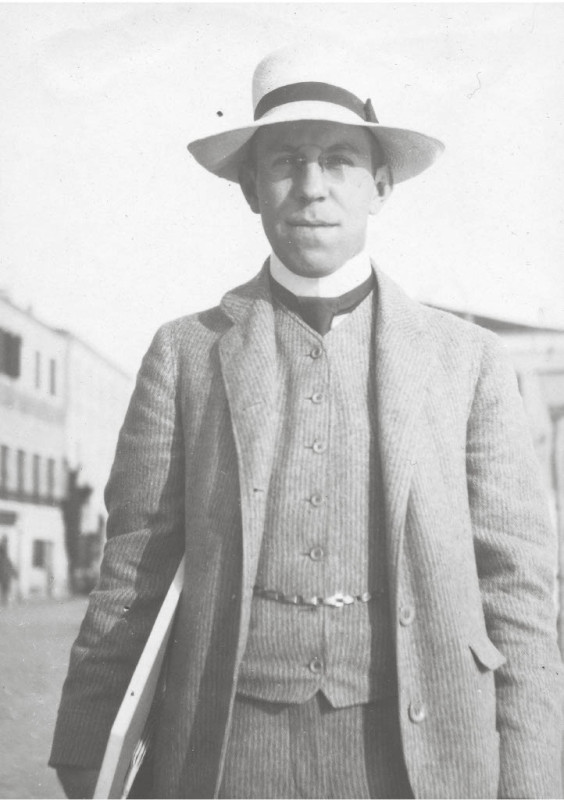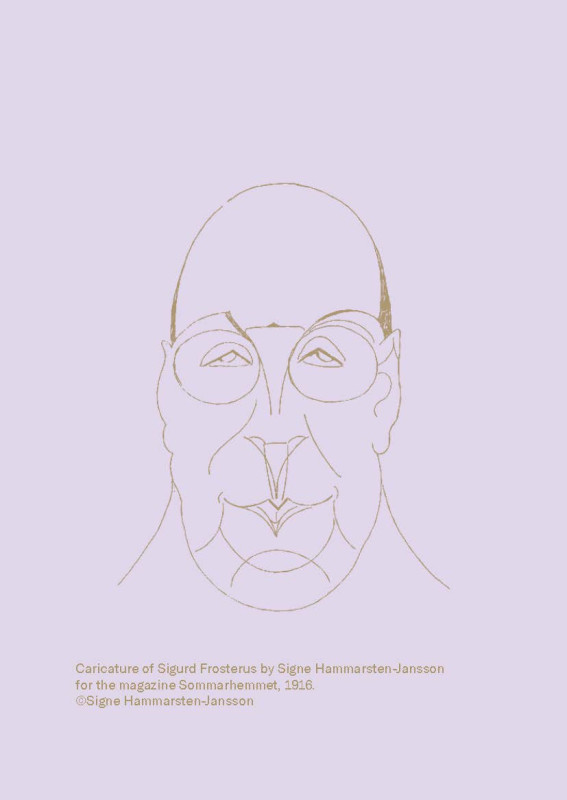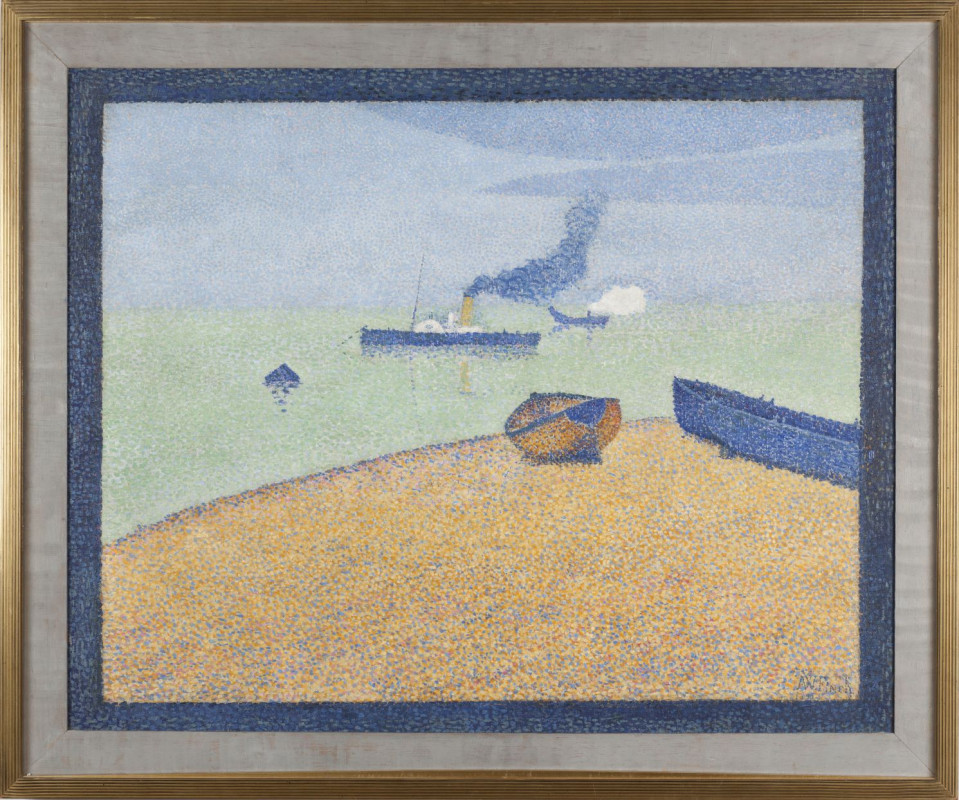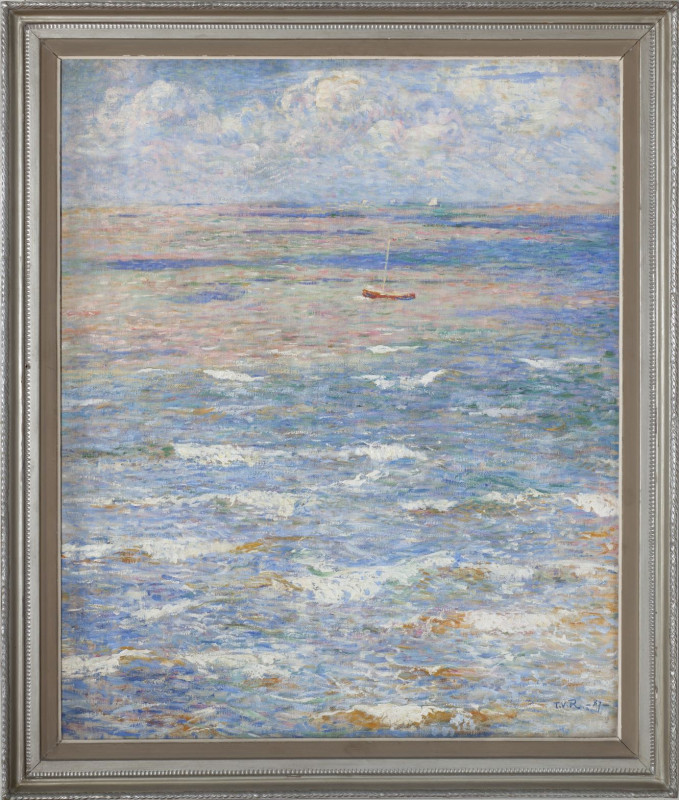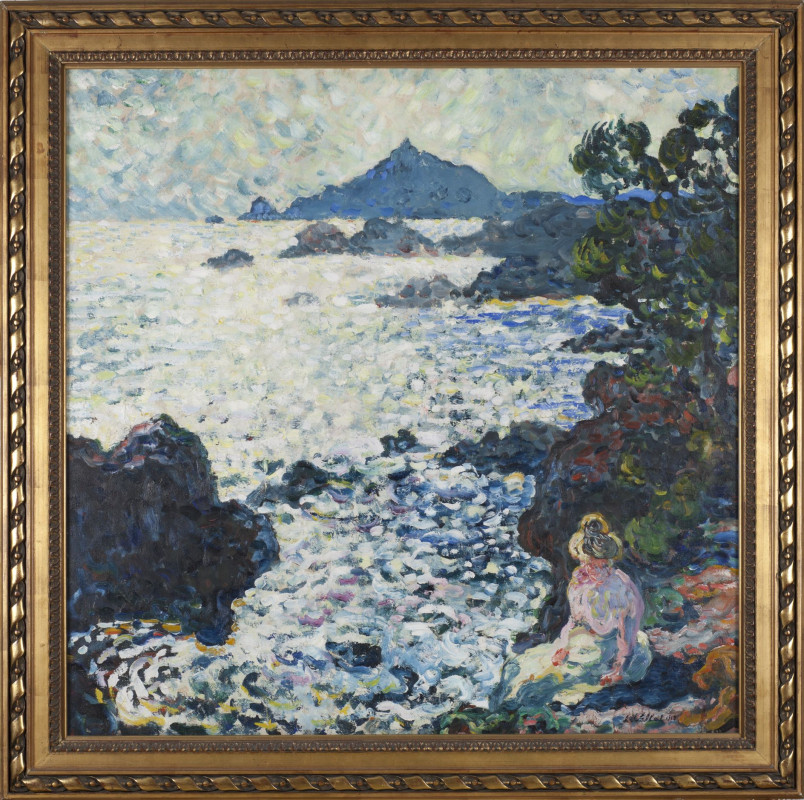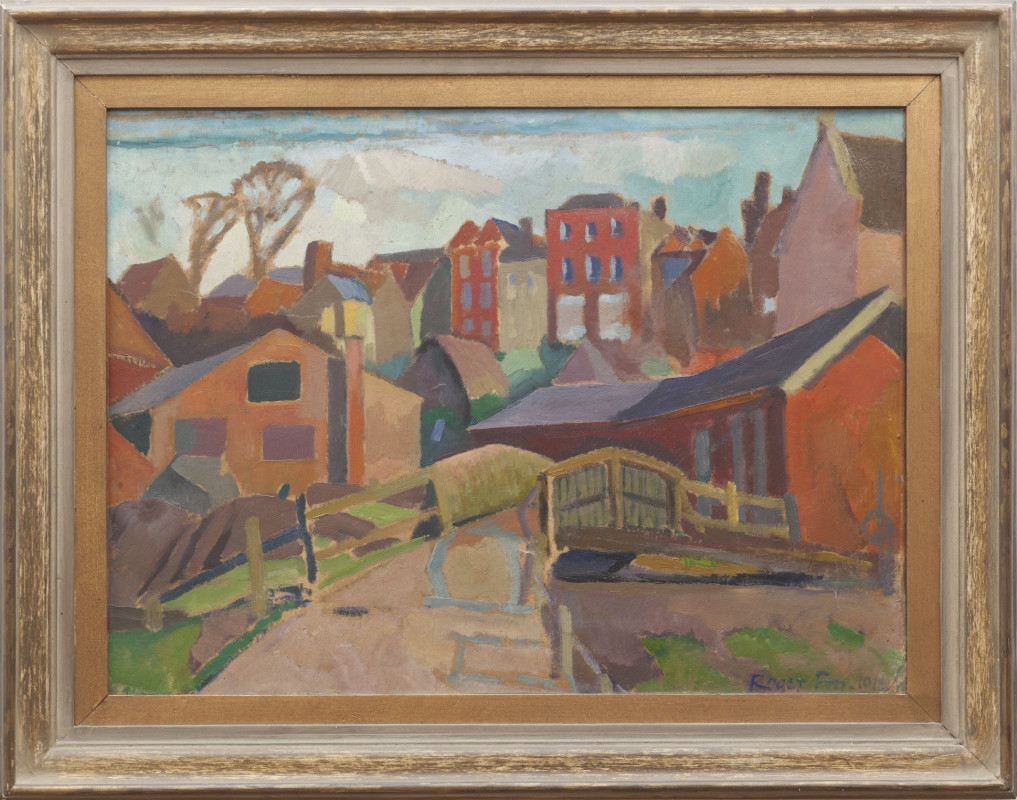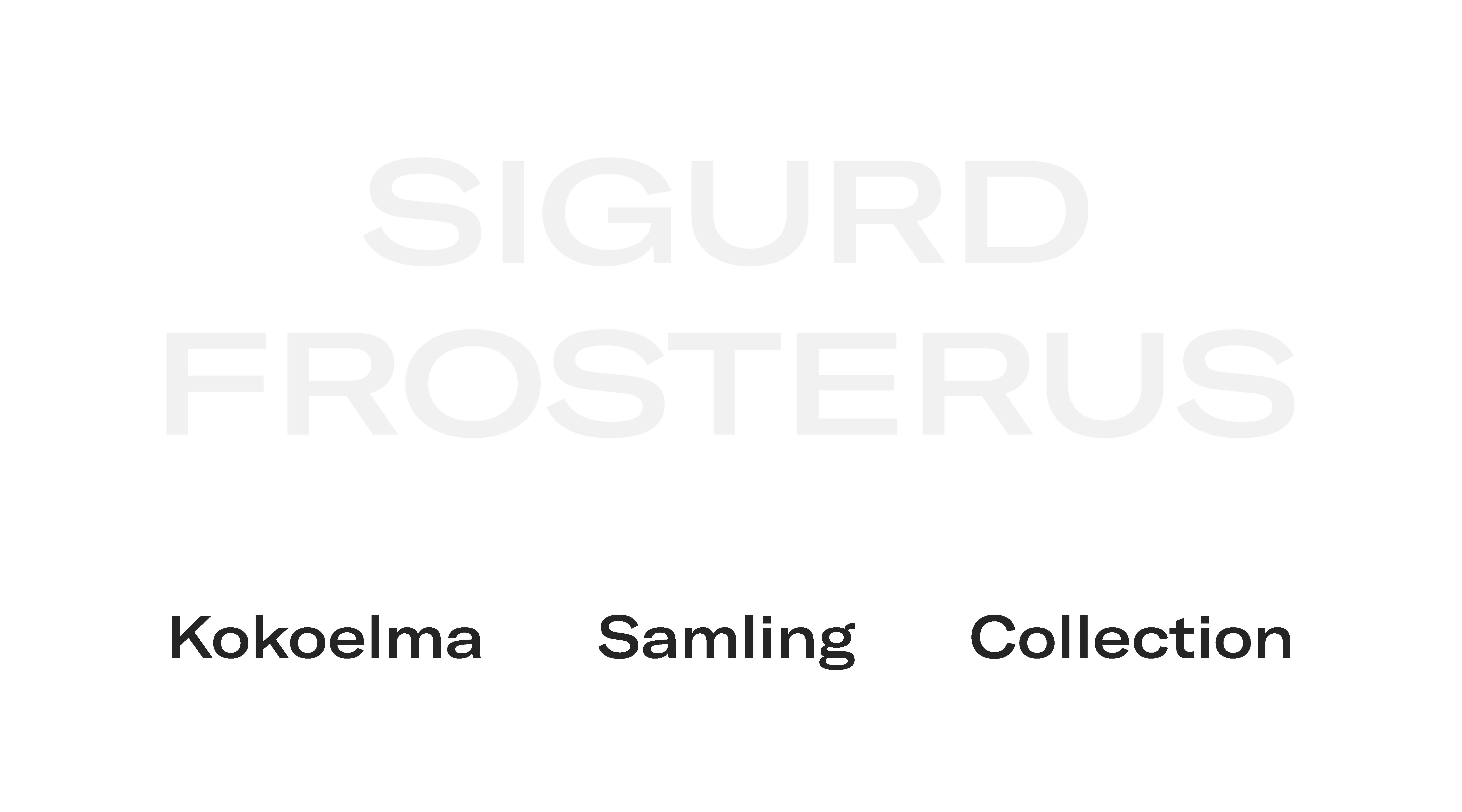
THE SIGURD FROSTERUS COLLECTION
![]()
Sigurd Frosterus
Sigurd Frosterus’s post-impressionist art collection has been on deposit at the Amos Anderson Art Museum for nearly 25 years. The collection is owned by the Sigurd Frosterus Foundation, which was established in 1988 by Frosterus’s daughters, Johanna Weckman and Clara Ekholm, to preserve their father’s memory, art collection and intellectual legacy. The collection gives our visitors insight into a very personal view of early Modernism in 20th-century Finland. The art collector Sigurd Frosterus, who was active in the first half of the 20th century, is primarily known as the architect of the Stockmann department store in the centre of Helsinki. But he was an extraordinarily multifaceted and gifted cultural personality. Besides an architect, he was an essayist, a critic, an art theoretician and a passionate connoisseur of colour. His broad interest spanned various kinds of art, and extended from the Renaissance to his own era. It is therefore fitting that a room should be dedicated to his collection in the Amos Rex complex where new and old intersect in the architecture and exhibition programme. The Sigurd Frosterus Collection is an important part of the museum’s quest to show the vitality and various guises of art throughout time. It is with great pleasure that Amos Rex, in cooperation with the Sigurd Frosterus Foundation, presents the collection in its brand-new home.
Welcome to the Sigurd Frosterus Room!
Kai Kartio, Museum Director
SIGURD FROSTERUS (1876–1956)
1876
Born on 4 June, in Asikkala, in the province of Häme, the first child of engineer Theodor Frosterus and Ida Frosterus (née Carp).
1895–1896
Graduates from Nya Svenska Läroverket boys’ school and begins studying art history and aesthetics at the Imperial Alexander University (now the University of Helsinki).
1899–1902
Completes a master’s degree in art history and contemporary literature 1899. Graduates as an architect from the Polytechnic Institute (now Aalto University) 1902 and establishes an architecture firm (1902–1906) with fellow student Gustaf Strengell.
1903–1904
Works in the design and architecture firm of Henry van de Velde in Weimar, Germany. Becomes acquainted there with the works of the most famous European colourists and the collectors of their works. Debuts as an art critic in 1903 in the Helsingfors-Posten newspaper where he advocates for modern art. Enters the design competition for the Helsinki railway station with his proposal Eureka (1904).
Publishes with Gustaf Strengell Arkitektur. En stridskrift våra motståndare tillägnad (Architecture. A Challenge to our Opponents) (1904) where they criticize the National Romanticism of Eliel Saarinen’s winning entry in the railway design contest.
1906–1907
Publishes H. G. Wells (1906). Marries Emmy von Kraemer. On their honeymoon the couple acquire Paul Signac’s Seine, Grenelle (1899), which becomes the first documented acquisition of the Frosterus collection.
1908–1911
Editor in chief of the journal Arkitekten. Daughter Johanna is born in 1908 and daughter Clara in 1909. Moves in 1910 with his family into a building he designed at Töölönkatu 7 in Helsinki. The building is in the style of rational art nouveau with scant ornamentation.
1912
The first Finnish artists group, Septem, is founded. Frosterus is among the group’s driving forces and together with the artist Magnus Enckell he defends painting with unmixed colours.
1914–1915
Abandons art criticism and focuses instead on architecture and aesthetics. Travels to England where he meets the art critic and artist Roger Fry in 1914. The first exhibition of the Frosterus collection is held at the Ateneum in 1915. Publishes Olikartade skönhetsvärden (Various Beauty Values) and Moderna vapen, deras uppkomst och utveckling (Modern Weapons, their Origin and Development) (1915).
1916–1917
Commissioned to design the Stockmann department store in 1916 (the building is not completed until 1930). Publishes the essay collection Regnbågsfärgernas segertåg (The Triumph of Rainbow Colours) (1917), promoting the concept of pure painting and the status of light painting.
1918–1930
Establishes with Ole Gripenberg an architecture firm focused on housing design (1918–1935). Their most famous work is a block of apartment buildings in Helsinki’s Taka-Töölö district, the so-called Gripenberg Block. Completes a doctoral dissertation on the problem of colour in painting, in 1920. Publishes Skyskrapan hägrar (The Skyscraper Looms) (1922). Moves in 1927 with his family into a building he designed in a Nordic classicist style at Töölönkatu 12. Publishes Jorden krymper, Jorden växer (The Earth Shrinks, the Earth Grows) (1930).
1935–1946
Publishes the essay collection Stålålderns janusansikte och andra essäer (Janus Face of the Steel Age and Other Essays) (1935). Frosterus’s art collection features in the exhibition 14 Private Collections of New Finnish Art at the Kunsthalle Helsinki in 1936. Publishes Nordiskt i dur och moll (Nordic in Major and Minor) (1946).
1950–1955
Appointed an honorary member of the Finnish Academy of Fine Arts 1950. The collection is exhibited at Galerie Artek in 1955.
1956
Dies at home in Helsinki on 2 March.
1994
The Frosterus collection is deposited with the Amos Anderson Art Museum in Helsinki. The deposit is administered by the Sigurd Frosterus Foundation established by his daughters in 1988. The collection comprises 99 paintings, 14 drawings, 10 prints and 12 ceramic items.
PAUL SIGNAC, Seine, Grenelle
PAUL SIGNAC (1863–1935), Seine, Grenelle, 1899
Seine, Grenelle by the French developer of the pointillist style Paul Signac, is the collection’s first documented acquisition. Sigurd and Emmy Frosterus set off on their honeymoon, via Weimar, to Venice in 1907. During the voyage, they bought this neo-impressionist painting at a friendly price from Frosterus’s mentor, the Belgian architect Henry van de Velde.
This figurative colour study has a dual aspect: on the one hand, it features a brave, new, industrialised world with barges, factory silhouettes and smokestacks with rising plumes of smoke, while, on the other, fishermen ply their traditional trade from the shore and small fishing vessels. It is as if the hallmarks of the new era are smoking out the old world, driving it into an ever-shrinking space on the edge of the painting.
The shapes in the painting are formed by the small dots of colour. Against the shimmering sky gleams the Eiffel Tower, built ten years earlier for the Paris World’s Fair. Next to it, right beside the pont de Grenelle, the small-scale replica of New York’s famous Statue of Liberty holds up her torch.
ALFRED WILLIAM FINCH, Steamers on the Coast
ALFRED WILLIAM FINCH (1854–1930), Steamers on the Coast, 1890
The weather covering the fields of colour in Alfred William Finch’s Steamers on the Coast is oppressive, and the contrasts are blurred in a soft pointillism that reaches all the way to the frame. The steamship emitting thick, blue billows of steam provides a fixed point for the gaze, which otherwise could wander off to the boats thrown against the shoreline and between the sand, water and sky.
Anglo-Belgian Finch, who lived in Finland from 1897 until his death, became a good friend and an important artist to Sigurd Frosterus. Known also as a designer, Finch moved to Finland to manage the ceramics department of the artist Louis Sparre’s Iris furniture factory. Later he worked as a ceramics instructor at the Central School of Applied Arts and, after the Iris business collapsed in 1902, he once again took up his brush after a break of many years.
In addition to the paintings of Magnus Enckell, Finch’s works form the backbone of the collection, and Finch has been called the key to Frosterus’s aesthetic world. A. W. Finch also served as a kind of liaison between the art worlds of Finland and Europe. Through him Frosterus obtained an internship in 1903 at the architecture firm of Henry van de Velde, which proved decisive for his career and mindset.
THÉO VAN RYSSELBERGHE, Marine
THÉO VAN RYSSELBERGHE (1862–1926), Marine, 1887
The fresh breeze is palpable when looking at the whitecaps glistening in the sunlight of this oldest oil painting in the Frosterus collection. Sailing vessels glide along the high horizon, while a small boat with sails furled floats closer in the swells, accentuating the impression of depth. Waves beat against the shore. The open sea and cloud-dotted sky form different fields whose brushstrokes emphasize the painterliness of the work.
Marine is an early work by the Belgian Théo van Rysselberghe, painted before he shifted to the pointillist style. But the painting heralds the coming change: the dots and dashes are emerging, and the colours are nearly pure. The representational aspect is pared down, and van Rysselberghe seems more concerned with studying colour, light and motion than with depicting the boats in detail. The artist belonged to the same Les Vingt group of young, radical painters as its founding member A.W. Finch and others, including Auguste Rodin and Paul Signac.
MAGNUS ENCKELL, Portrait of Emmy Frosterus
MAGNUS ENCKELL (1870–1925), Portrait of Emmy Frosterus, 1909
In the first decade of the 20th century, Magnus Enckell’s painting went through an experimental phase, shifting from dark and sombre colours to a brighter, purer palette. At the time, the European art world was in turmoil: Modernism was reassessing art’s role, and artists began to question precise representation as the primary objective of art. The Finnish section at the 1908 Salon d’Automne in Paris got a mixed reception. The display enchanted some visitors, but others found it dull and trivial. Many artists took the criticism to heart and began studying the new French painting and the opportunities of the pure palette.
Magnus Enckell and art critic Sigurd Frosterus stood in the front lines when the wave of Modernism washed over the Finnish art world. Frosterus commissioned Enckell to paint a portrait of his wife Emmy. In this so-called “white portrait” painted in the summer of 1909, the model has directed her doe-eyed gaze out over the open sea. The white parasol together with the white summer dress make the work bright and airy, and provide a contrast to the colouristic background. Enckell was delighted by the idea of painting the portrait outdoors, en plein air. He photographed his subject and diligently sketched, but the task began to frustrate him, and he was not satisfied with the outcome. A year later he tried again to portray Emmy, this time indoors. In the new portrait, the artist preserved some elements of the original version, such as the violet and yellow-hued shady pine forest, which he simplified into a decorative background gleaming in rainbow colours.
MAGNUS ENCKELL, Boys on the Beach
MAGNUS ENCKELL (1870–1925), Boys on the Beach, 1910
The day is tilting towards evening, and the games are winding down. The ochre-coloured light of a late summer’s evening casts long, blue shadows on the sandy shore. A reclining boy gazes absentmindedly at his friend, who hurls a stone with all his might into the calm sea. This work was painted on the island of Suursaari, a popular summer retreat off Kotka, where Magnus Enckell and Verner Thomé spent the summer of 1910. Both artists were in the midst of an intensive colourist phase, and they repeatedly depicted the northern summer light with pure colours squeezed straight from the tube. Their interpretations of the same beach scene differ considerably, however: with its careful and precise dots, Thomé’s depiction of the playing boys adheres to a more rigorous neo-impressionistic style than Enckell’s, which is painted more independently and with a freer brush. The sky and sea are painted with short, fragmented brushstrokes, whereas the figures and boulders in the foreground are done with elegant, long strokes. The artist is poised in this work between his recently embraced Pointillism and pure palette and the elongated lines and nude studies of his earlier symbolist period. Boys on the Beach is considered one of the highlights of Finnish Colourism.
LOUIS VALTAT, Marine, Cap Nègre
LOUIS VALTAT (1869–1952), Marine, Cap Nègre, 1902
The French artist Louis Valtat’s seascape from 1902 is a study in backlighting. The majestic Cap Nègre rises in the background from a Mediterranean Sea glistening and seething in the sunlight. Valtat depicts the frothing breakers striking furiously against the rocks in the foreground in ultramarine, mint green, yellow and white. The light falling obliquely from left to right casts shadows behind the rocks in the middle of the work and behind the woman figure. The backlight heightens the dramatic atmosphere but prevents a sense of depth from emerging by flattening the picture. Instead, Valtat creates an impression of distance with an aerial perspective: the dark boulders in the foreground and the transition to the ultramarine mountain peak reinforce the notion of depth. The figure in the foreground further accentuates it by giving scale to the landscape. Valtat maintains the flattening effect of the backlighting in certain features, such as the fierce waves hungrily licking at the trailing hem of the woman’s dress, in brushstrokes that waver between figurative and pure abstraction.
PIERRE BONNARD, La Sieste
PIERRE BONNARD (1867–1947), La Sieste, 1909
Sigurd Frosterus wrote that in Pierre Bonnard’s La Sieste “gems of colour rest as if on velvet.” The atmosphere in the painting is indeed peaceful, but also voluptuous in its hazy green tones; new details can be found in this work every time. A dog lying behind the chair and the geraniums guards the white-dressed figure’s moment of repose in the garden. The lingering atmosphere of late summer turns to grey and violet. The same colour scheme can be seen in Magnus Enckell’s later work, and he probably examined Bonnard’s painting at the home of his friend Frosterus. The painting was shown at the Ateneum, in a group exhibition in 1913, and two years later in an exhibition of the Frosterus collection.
The painting’s charm lies in its restfulness, but also in its subtle power and spontaneous atmosphere. The woman casually occupying her own space in a lawn chair has set her legs on top of a chair almost brazenly placed in the middle of the pathway. Anyone who would arrive to disturb this moment would probably have to cross the lawn to get past.
ROGER FRY, Guildford
ROGER FRY (1866–1934), Guildford, 1912
In the summer of 1914, Sigurd Frosterus visited the home of the renowned British art critic and artist Roger Fry in the English town of Guildford, where he received this cubist-inspired work as a gift from the painter. Roger Fry belonged to the Bloomsbury Group whose members brought new French painting and Modernism to England. The group included the author Virginia Woolf, of whom Fry has painted a delicate portrait. Fry had a major impact on modernist theory, but is known especially as the originator of the term “Post-Impressionism.” The term refers to the movement that took place after Impressionism and which meant, among other things, the freer and more intensive use of light and colour by artists. The concept aptly describes the Frosterus collection.
Fry’s penchant for theory is apparent in the restraint of Guildford. The absence of human figures emphasizes the artificial, stage-set aspect of the landscape, but the rhythmic play of colour and form renders the work bright and clear. The colour scheme is dominated by powerful sienna brown, umber and ochre tones, which give the painting a warm overall impression. Random inklings of green and blue in the cityscape, as well as various nuances of turquoise in the sky, add a touch of coolness and lightness, providing a unifying tension between cold and warm tones. The upwardly growing city, with its sculptural buildings, brings tridimensionality and illusion of depth to the work.


